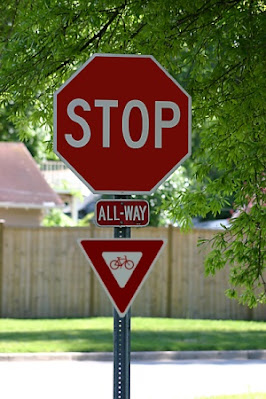Stop As Yield
A stop sign with a bicycle yield.
Photographer and copyright unknown. Source, Raise the Hammer
Desired Outcomes of the Proposed Stop-as-Yield Law
Enhanced Safety
The primary goal of the stop-as-yield law is to significantly increase road safety for cyclists. By allowing cyclists to maintain momentum at intersections—where they can safely do so—we anticipate reducing collisions and conflicts with motor vehicles. This law acknowledges the unique maneuverability of bicycles and their riders' ability to assess and respond to traffic conditions in real time, thereby reducing the likelihood of accidents and enhancing overall road safety.
Boosted Productivity
Implementing a stop-as-yield law is expected to contribute positively to our gross domestic product (GDP). By streamlining urban traffic flow and reducing delays for cyclists, we not only enhance efficiency but also encourage more people to choose cycling as a primary mode of transportation. This shift can lead to decreased congestion, lower transportation costs, and improved environmental health, all conducive to higher productivity and economic growth.
Improved Health Outcomes
The stop-as-yield policy is designed to promote cycling as a healthier, more accessible mode of transportation. By making cycling more appealing and safer, we expect increased physical activity among the population, leading to widespread health benefits. Regular cycling has been linked to reduced risks of heart disease, stroke, obesity, and other lifestyle-related conditions. This policy aims to foster a more active, health-conscious society.
Enhanced Lifestyle Quality
Finally, the proposed law seeks to enhance the quality of life for all residents by creating a more livable, cycle-friendly environment. Encouraging cycling helps reduce environmental pollution and contributes to a quieter, more serene urban atmosphere. It supports the development of a vibrant, active community where residents enjoy improved connectivity and accessibility, fostering a sense of well-being and community cohesion.
Implementation of 'Stop as Yield' for Cyclists
Abbotsford Policy Corner advocates for a transformative approach to urban mobility by introducing a 'Stop as Yield' policy for cyclists at non-signalized intersections. Supported by evidence showing a 14% reduction in crash rates and diminished severity of injuries, this proposal emphasizes the benefits of allowing cyclists to yield rather than halt completely. Compared to motor vehicles, the agility and enhanced visibility of bicycles justify this shift. By reducing the need for cyclists to stop completely—from a six-second halt to a mere two-second yield—this policy aims to streamline bicycle traffic while bolstering safety. Traditional stop signs, engineered with motor vehicles in mind, overlook bicycles' unique advantages to urban navigation.
Transition from Stop Signs to Yield Signs for Motor Vehicles
In conjunction with the 'Stop as Yield' initiative for cyclists, Abbotsford Policy Corner suggests reevaluating stop sign usage in favour of yield signs for motor vehicles in appropriate contexts. This recommendation targets areas with slow-speed designs and clear visibility, enhanced by:
- Continuous sidewalks at crosswalks and driveways, prioritizing pedestrian safety and presence.
- Elevated intersections or sidewalks naturally moderate vehicle speed.
- Use brick surface treatments to discourage speeding through tactile and audible feedback.
This policy adjustment encourages a shift from the binary stop-and-go mentality to a more nuanced, safety-first approach. By emphasizing the significance of yielding over stopping, Abbotsford Policy Corner aims to foster a more adaptable, aware, and responsible road usage culture, reflecting all urban travellers' diverse needs and safety.
British Columbia Case Studies
1) Tailored Traffic Instructions by Vehicle Type
British Columbia Motor Vehicle Act allows for different vehicle types to receive distinct traffic instructions at the same intersection, promoting safety and efficiency tailored to the unique characteristics of each mode of transport. A prime example is in Victoria, at Pandora Avenue and the Johnson Street Bridge. Here, signage explicitly differentiates between the operational directives for bicycles and motor vehicles, offering an adaptive framework that acknowledges and accommodates the disparate dynamics of cars and bikes. This differentiation enhances safety and streamlines traffic flow by leveraging the inherent advantages of each transportation mode.
2) In Salmo, British Columbia, yield signs are used instead of stop signs at some intersections. However, a design flaw is that the motor vehicle is not made to feel like a 'guest' at the intersection, an essential characteristic of making this policy work. On Google Streetview in Salmo, see the intersection of Seventh and Sayward.
'Stop as Yield' Literature Review
Note: Stop as yield is sometimes called the Idaho stop, where the rule first became law in 1982.
"Stop or yield? New research supports law change for cyclists," by Chad Pawson, CBC News - September 7, 2024
"Stop Signs Suck, and We Should Get Rid of Them," published by Not Just Biked on YouTube - January 13, 2020
"Delaware yield crash data," by Bike Delaware
"Time to Embrace Proven Good Ideas in Livability," by Jason Leach, Raise the Hammer - November 9, 2011
Material from Twitter:
Material from Twitter:
= = =
Keywords: Idaho Stop, 1982, Intersection Design, Stop-as-Yield Law, Cyclist Safety, Urban Cycling Policies, Traffic Flow Efficiency, Economic Benefits of Cycling, Health Benefits of Cycling, Sustainable Urban Mobility, Gross Domestic Product (GDP) and Cycling, Active Transportation, Road Safety Innovations, Bicycle-Friendly Cities, Environmental Benefits of Cycling, Lifestyle Improvement through Cycling, Cycling Advocacy, Traffic Law Reform

